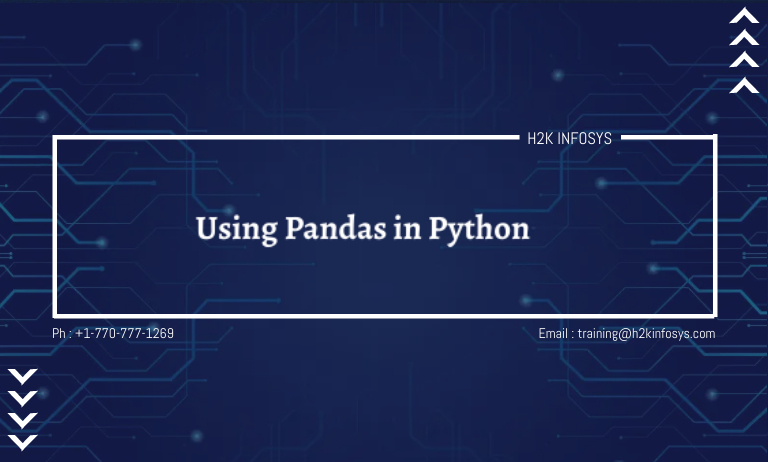Python panda is considered a python library used for working with data sets. This functions for analyzing, cleaning, exploring, and manipulating data. Its name panda is taken as both “panel data” and “Python data analysis” and is created by Wes McKinney in 2008.
Pandas used to get to know big data and also make conclusions that are based on statistical theories. Pandas can clean messy data sets and them readable and relevant. This relevant data is very important in data science. Pandas will be able to delete rows that are not relevant or may contain wrong values like empty or NULL values. This is called cleaning data. Pandas are considered an open-source python library that is utilized for high-performance data manipulation and data analysis by using its powerful data structures. Python with pandas will be in use in a variety of academic and commercial domains, including finance, economics, statistics, advertising, web analytics. By pandas, we can accomplish five typical steps in the processing and analysis of data, apart from the origin of data load, organize, manipulate, model, and analyze the data.
Key features:
- They are fast and efficient DataFrame object with default and customised indexing.
- There are tools for loading data into in-memory data objects from various different formats.
- The data alignment and also combined handling of missing data.
- Reshaping and pivoting of data sets.
- Label based slicing, indexing and also subsetting of large data sets.
- The columns from the data structures can be deleted or may be inserted.
- The group of data for aggregation and transformation.
- The high performance joining of data
- Time series are functionality.
The pandas will consist of three data structures
- Series
- DataFrame
These data structures will be built on top of a Numpy, array, making them fast and efficient
The dimension and description
There is a better way to think of these data structures that are a higher-dimensional data structure that is the container of their lower-dimensional data structure. Consider an example, DataFrame will be a container of series, the panel is a container of DataFrame.
| Data structure | Dimension | Description |
| Series | 1 | 1D labeled homogenous array, size-immutable. |
| Data Frame | 1 | General 2D labeled, which is a size-mutable tabular structure with potential heterogeneously typed columns. |
Here the dataframe will be widely used and it is the most important data structure.
The Series is known as a one-dimensional array-like structure with the same data. Considering the series or maybe collection of integers 10, 23, 56 can be written as
10, 23, 56, 17, 52, 61, 73, 90, 26, 72
The main points of the series are
- Homogenous data
- size immutable
- value of data mutable
DataFrame
DataFrame will be of the two-dimensional array with heterogeneous data. For example
| Name | Age | Gender | Rating |
| Raghav | 32 | Male | 3.45 |
| Mia | 28 | Female | 4.6 |
| Rahul | 45 | Male | 3.9 |
| Meenal | 38 | Female | 2.78 |
Here the table represents the data of the data sales team of an organization with all overall performance ratings. This data will be represented in rows and columns. Each column represents attributes and each row represents an attribute and each row represents a person.
Main points of DataFrame:
- Heterogenous data
- Size mutable
- Data Mutable
Working with pandas
Loading and saving the data with pandas
Whenever we want to use the pandas for data analysis, we will be usually use it in one of the three different ways
- By converting a python’s list, dictionary or Numpy array to pandas data frame.
- By open a local file using pandas,u sually a CSV file but could also delimited text file and excel etc.
- By opening a remote file or database like CSV or may be JSON on website through a URL or read from SQL table/database
We have a different command to each of these options but when we open a file it will look like
pd.read_filetype()
There are different types of pandas that can work with so we can replace “filetype” with the actual, well, filetype. We would give the path, filename, etc inside the parenthesis.
Questions
- What is meant by Python Pandas? Explain its features?
- What are the data structures of Python pandas?





























14 Responses
Python panda is considered a python library used for working with data sets. This functions for analyzing, cleaning, exploring, and manipulating data. Its name panda is taken as both “panel data” and “Python data analysis” and is created by Wes McKinney in 2008.
They are fast and efficient DataFrame object with default and customised indexing.
There are tools for loading data into in-memory data objects from various different formats.
The data alignment and also combined handling of missing data.
Reshaping and pivoting of data sets.
Label based slicing, indexing and also subsetting of large data sets.
The columns from the data structures can be deleted or may be inserted.
The group of data for aggregation and transformation.
The high performance joining of data
Time series are functionality.
H2kinfosys Blog
Home
About Us
Courses
Tutorials
Skill Test
Contact Us
Search for
Sidebar
Log In
Follow
All IT Courses 50% Off
Home/Python Tutorials/Using Pandas in Python
Python Tutorials
Using Pandas in Python
Pradeep KumarFebruary 15, 20220 218 3 minutes read
Using Pandas in Python Using Pandas in Python
Python panda is considered a python library used for working with data sets. This functions for analyzing, cleaning, exploring, and manipulating data. Its name panda is taken as both “panel data” and “Python data analysis” and is created by Wes McKinney in 2008.
Pandas used to get to know big data and also make conclusions that are based on statistical theories. Pandas can clean messy data sets and them readable and relevant. This relevant data is very important in data science. Pandas will be able to delete rows that are not relevant or may contain wrong values like empty or NULL values. This is called cleaning data. Pandas are considered an open-source python library that is utilized for high-performance data manipulation and data analysis by using its powerful data structures. Python with pandas will be in use in a variety of academic and commercial domains, including finance, economics, statistics, advertising, web analytics. By pandas, we can accomplish five typical steps in the processing and analysis of data, apart from the origin of data load, organize, manipulate, model, and analyze the data.
Key features:
They are fast and efficient DataFrame object with default and customised indexing.
There are tools for loading data into in-memory data objects from various different formats.
The data alignment and also combined handling of missing data.
Reshaping and pivoting of data sets.
Label based slicing, indexing and also subsetting of large data sets.
The columns from the data structures can be deleted or may be inserted.
The group of data for aggregation and transformation.
The high performance joining of data
Time series are functionality.
The pandas will consist of three data structures
Series
DataFrame
These data structures will be built on top of a Numpy, array, making them fast and efficient
The dimension and description
There is a better way to think of these data structures that are a higher-dimensional data structure that is the container of their lower-dimensional data structure. Consider an example, DataFrame will be a container of series, the panel is a container of DataFrame.
Data structure Dimension Description
Series 1 1D labeled homogenous array, size-immutable.
Data Frame 1 General 2D labeled, which is a size-mutable tabular structure with potential heterogeneously typed columns.
Here the dataframe will be widely used and it is the most important data structure.
The Series is known as a one-dimensional array-like structure with the same data. Considering the series or maybe collection of integers 10, 23, 56 can be written as
10, 23, 56, 17, 52, 61, 73, 90, 26, 72
1) What is meant by Python Pandas? Explain its features?
* Pandas is a Python library. Pandas is used to analyze data.
* Pandas has been one of the most commonly used tools for Data Science and Machine learning, which is used for data
Key features:
1) cleaning and analysis.
2) Fast and efficient DataFrame object with default and customized indexing.
3) Tools for loading data into in-memory data objects from different file formats.
4) Data alignment and integrated handling of missing data.
5) Reshaping and pivoting of date sets.
6) Label-based slicing, indexing and subsetting of large data sets.
7) Columns from a data structure can be deleted or inserted.
8) Group by data for aggregation and transformations.
9) High performance merging and joining of data.
10) Time Series functionality.
2) What are the data structures of Python pandas?
Pandas deals with the following three data structures −
* Series
* DataFrame
* Panel
* Series
Series is a one-dimensional array like structure with homogeneous data. For example, the following series is a collection of integers 10, 23, 56, …
Key Points
Homogeneous data
Size Immutable
Values of Data Mutable
* DataFrame
DataFrame is a two-dimensional array with heterogeneous data. For example,
Key Points
Heterogeneous data
Size Mutable
Data Mutable
* Panel
Panel is a three-dimensional data structure with heterogeneous data. It is hard to represent the panel in graphical representation. But a panel can be illustrated as a container of DataFrame.
Key Points
Heterogeneous data
Size Mutable
Data Mutable
Python panda is considered a python library used for working with data sets. This functions for analyzing, cleaning, exploring, and manipulating data. Its name panda is taken as both “panel data” and “Python data analysis” and is created by Wes McKinney in 2008.
A.Pandas used to get to know big data and also make conclusions that are based on statistical theories. Pandas can clean messy data sets and them readable and relevant. This relevant data is very important in data science. Pandas will be able to delete rows that are not relevant or may contain wrong values like empty or NULL values. This is called cleaning data. Pandas are considered an open-source python library that is utilized for high-performance data manipulation and data analysis by using its powerful data structures. Python with pandas will be in use in a variety of academic and commercial domains, including finance, economics, statistics, advertising, web analytics. By pandas, we can accomplish five typical steps in the processing and analysis of data, apart from the origin of data load, organize, manipulate, model, and analyze the data.
FEATURES.
1. They are fast and efficient DataFrame object with default and customised indexing.
2. There are tools for loading data into in-memory data objects from various different formats.
3. The data alignment and also combined handling of missing data.
4. Reshaping and pivoting of data sets.
5. Label based slicing, indexing and also subsetting of large data sets.
6.The columns from the data structures can be deleted or may be inserted.
7. The group of data for aggregation and transformation.
8. The high performance joining of data
9. Time series are functionality
. B.The pandas will consist of three data structures-
Series
DataFrame
These data structures will be built on top of a Numpy, array, making them fast and efficient.
1.What is meant by Python Pandas? Explain its features?
-Python panda is considered a python library used for working with data sets. This functions for analyzing, cleaning,
exploring, and manipulating data. By pandas, we can accomplish five typical steps in the processing and analysis of
data, apart from the origin of data load, organize, manipulate, model, and analyze the data. Pandas are considered an
open-source python library that is utilized for high-performance data manipulation and data analysis by using its
powerful data structures. Python with pandas will be in use in a variety of academic and commercial domains,
including finance, economics, statistics, advertising, web analytics.
Key features:
1.They are fast and efficient DataFrame object with default and customized indexing.
2.There are tools for loading data into in-memory data objects from various different formats.
3.The data alignment and also combined handling of missing data.
4.Reshaping and pivoting of data sets.
5.Label based slicing, indexing and also subsetting of large data sets.
6.The columns from the data structures can be deleted or may be inserted.
7.The group of data for aggregation and transformation.
8.The high performance joining of data
9.Time series are functionality.
2.What are the data structures of Python pandas?
Pandas, a data analysis library, supports two data structures:
a. Series: one-dimensional labeled arrays pd.Series(data)
A series can be seen as a one-dimensional array. The data structure can hold any data type, that is including
strings, integers, floats and Python objects.
b. DataFrames: two-dimensional data structure with columns, much like a table.
What is meant by Python Pandas? Explain its features?
Python panda is considered a python library used for working with data sets. This functions for analyzing, cleaning, exploring, and manipulating data. Its name panda is taken as both “panel data” and “Python data analysis” and is created by Wes McKinney in 2008.
1.They are fast and efficient DataFrame object with default and customised indexing.
2.There are tools for loading data into in-memory data objects from various different formats.
3.The data alignment and also combined handling of missing data.
4.Reshaping and pivoting of data sets.
5.Label based slicing, indexing and also subsetting of large data sets.
6.The columns from the data structures can be deleted or may be inserted.
7.The group of data for aggregation and transformation.
8.The high performance joining of data
9.Time series are functionality.
2,What are the data structures of Python pandas?
There are three main data structures in pandas
Series
DataFrame
Panel
Python panda is considered a python library used for working with data sets. This functions for analyzing, cleaning, exploring, and manipulating data. Its name panda is taken as both “panel data” and “Python data analysis” and is created by Wes McKinney in 2008.
Pandas used to get to know big data and also make conclusions that are based on statistical theories. Pandas can clean messy data sets and them readable and relevant. This relevant data is very important in data science. Pandas will be able to delete rows that are not relevant or may contain wrong values like empty or NULL values. This is called cleaning data. Pandas are considered an open-source python library that is utilized for high-performance data manipulation and data analysis by using its powerful data structures. Python with pandas will be in use in a variety of academic and commercial domains, including finance, economics, statistics, advertising, web analytics. By pandas, we can accomplish five typical steps in the processing and analysis of data, apart from the origin of data load, organize, manipulate, model, and analyze the data.
Key features:
They are fast and efficient DataFrame object with default and customised indexing.
There are tools for loading data into in-memory data objects from various different formats.
The data alignment and also combined handling of missing data.
Reshaping and pivoting of data sets.
Label based slicing, indexing and also subsetting of large data sets.
The columns from the data structures can be deleted or may be inserted.
The group of data for aggregation and transformation.
The high performance joining of data
Time series are functionality.
FEATURES.
1. They are fast and efficient DataFrame object with default and customised indexing.
2. There are tools for loading data into in-memory data objects from various different formats.
3. The data alignment and also combined handling of missing data.
4. Reshaping and pivoting of data sets.
5. Label based slicing, indexing and also subsetting of large data sets.
6.The columns from the data structures can be deleted or may be inserted.
7. The group of data for aggregation and transformation.
8. The high performance joining of data
9. Time series are functionality
. B.The pandas will consist of three data structures-
Series
DataFrame
These data structures will be built on top of a Numpy, array, making them fast and efficient.
Using Pandas in Python:
What is meant by Python Pandas? Explain its features?
Pandas are considered an open source python library that is utilized for high performance data manipulation and data analysis by using its powerful data structures.
By Pandas, we can accomplish five typical steps in the processing and analysis of data, apart from the origin of data load, organize, manipulate, model and analyze the data.
Features:
-Fast and efficient
-Tools for loading data
-Data alignment and combined handling
-Reshaping and pivoting of data sets
-Label based slicing, indexing and also subsetting of large data sets
-Columns from the data structures can be deleted or inserted
-Aggregation and transformation
-Joining of data
-Time series are functionality
What are the data structures of Python Pandas?
Series and DataFrame are the two data structures discussed under this heading.
Series:
The Series is a 1D labeled, homogeneous array and size immutable like the structure with the same data.
E.g: integers : 12, 76, 58, 40
Data Frame:
Data Frame is a 2D labeled, heterogeneous array and size mutable with columns of potentially different types.
E.g: students mark list :
Name D.O.B English Maths Science Social Orchestra
Harry 12/09/2011 98 87 99 78 80
Sugan 04/20/2011 96 97 88 79 97
Sindhu 10/25/2011 99 98 90 99 98
Python panda is considered as a python library used for working with data sets. This functions for analyzing, cleaning, exploring, and manipulating data. Its name panda is taken as both “panel data” and “Python data analysis” and is created by Wes McKinney in 2008.
Pandas used to get to know big data and also make conclusions that are based on statistical theories. Pandas can clean messy data sets and make them readable and relevant. This relevant data is very important in data science. Pandas will be able to delete rows that are not relevant or may contain wrong values like empty or NULL values. This is called cleaning data. Pandas are considered an open-source python library that is utilized for high-performance data manipulation and data analysis by using its powerful data structures. Python with pandas will be in use in a variety of academic and commercial domains, including finance, economics, statistics, advertising, web analytics. By pandas, we can accomplish five typical steps in the processing and analysis of data, apart from the origin of data load, organize, manipulate, model, and analyze the data.
features of python panda
They are fast and efficient DataFrame object with default and customised indexing.
There are tools for loading data into in-memory data objects from various different formats.
The data alignment and also combined handling of missing data.
Reshaping and pivoting of data sets.
Label based slicing, indexing and also subsetting of large data sets.
The columns from the data structures can be deleted or may be inserted.
The group of data for aggregation and transformation.
The high performance joining of data
Time series are functionality.
The pandas consist of three data structures
Series
DataFrame
1. What is meant by Python Pandas? Explain its features?
Python panda is considered a python library used for working with data sets. This functions for analyzing, cleaning, exploring, and manipulating data.
Pandas are fast and efficient DataFrame object with default and customised indexing, there are tools for loading data into in-memory data objects from various different formats, data alignment and also combined handling of missing data, reshaping and pivoting of data sets, label based slicing, indexing and also subsetting of large data sets, deleting or inserting columns from data structures, grouping data for aggregation and transformation, joining data, and functionality time series.
2. What are the data structures of Python pandas?
The data structures of Python pandas are Series, Dataframe, and Panel. Series is a one-dimensional array-like structure with the same data, while DataFrame is a two-dimensional array with heterogeneous data. A panel is a container of DataFrame, which is a size-mutable tabular structure with potential heterogeneously typed columns. The main points of DataFrame are heterogenous data, size mutable, data mutable, working with pandas, and loading and saving the data with pandas. The pandas will be built on top of a Numpy, array, making them fast and efficient.
What is meant by Python Pandas? Explain its features?
Pandas is an open-source Python Library providing high-performance data manipulation and analysis tool using its powerful data structures. The name Pandas is derived from the word Panel Data – an Econometrics from Multidimensional data. Pandas is a Python package providing fast, flexible, and expressive data structures designed to make working with “relational” or “labeled” data both easy and intuitive. It aims to be the fundamental high-level building block for doing practical, real-world data analysis in Python.
Key Features of Pandas –
a. Fast and efficient Data Frame object with default and customized indexing.
b. Tools for loading data into in-memory data objects from different file formats.
c. Data alignment and integrated handling of missing data.
d. Reshaping and pivoting of date sets.
e. Label-based slicing, indexing and sub setting of large data sets.
f. Columns from a data structure can be deleted or inserted.
g. Group by data for aggregation and transformations.
h. High performance merging and joining of data.
i. Time Series functionality.
What are the data structures of Python pandas?
Pandas deals with the following three data structures −
– Series
– DataFrame
– Panel
These data structures are built on top of Numpy array, which means they are fast.
1. Python panda is a library used to work with data sets. It can analyze, clean, explore, and manipulate data. Some features of the panda library are that it can reshape and pivot data sets, load data into in-memory data objects from various different formats, handle missing data, has high performance of joining data, has time series functionality, can aggregate and transform data, columns from data structures can be deleted or inserted, and has label based slicing, indexing and sub setting large data sets.
2. Pandas consists of three data structures: series, data frame and panel. These data structures are built on top of a NumPy array, making them fast and efficient. Series is known as a 1-dimensional array like structure with the same data. It is homogenous data, immutable size and value of data is mutable. Data Frame is a 2-D array with heterogeneous data. Data Frame has heterogeneous data, mutable size, and data. Panel is a 3-D data structure with heterogeneous data. It is hard to represent it in a graphical representation, but it can be illustrated as a container of a Data Frame. The data and size are mutable in panel.
1)What is meant by Python Pandas? Explain its features?
A)Python Pandas is a data manipulation library for Python. It provides data structures and tools for handling and
analyzing data in a more efficient way than using built-in Python data structures alone.
Here are some key features of Pandas:
-Data Structures: Pandas has two main data structures: Series and DataFrame. A Series is a one-dimensional array with labeled indexes, while a DataFrame is a two-dimensional table with labeled rows and columns. These structures make it easy to work with large datasets and perform complex operations.
-Data Cleaning: Pandas provides tools for cleaning, transforming, and manipulating data. You can drop missing values, fill in missing data, convert data types, and more.
-Data Aggregation: Pandas has functions for grouping and aggregating data. You can group data by specific columns and apply functions to the groups, such as sum, mean, max, and min.
-Data Visualization: Pandas can be used to create visualizations of your data using Matplotlib or other libraries. You can create bar charts, scatter plots, and more.
-Time Series Analysis: Pandas has extensive functionality for working with time series data. You can resample data to different time frequencies, compute rolling statistics, and more.
-Integration with Other Libraries: Pandas integrates well with other libraries in the Python data science ecosystem, such as NumPy, Scikit-learn, and TensorFlow.
2) What are the data structures of Python pandas?
A) Pandas has two main data structures: Series and DataFrame.
(a) Series: A Series is a one-dimensional labeled array that can hold any data type (integer, float, string, etc.). It is similar to a column in a spreadsheet or a SQL table. A Series has two main components: the index and the values. The index labels the data and the values are the actual data.
(b) DataFrame: A DataFrame is a two-dimensional labeled data structure with columns of potentially different types. It is similar to a spreadsheet or a SQL table. A DataFrame has two main components: the index and the columns. The index labels the rows and the columns label the columns. Each column can have a different data type (integer, float, string, etc.).